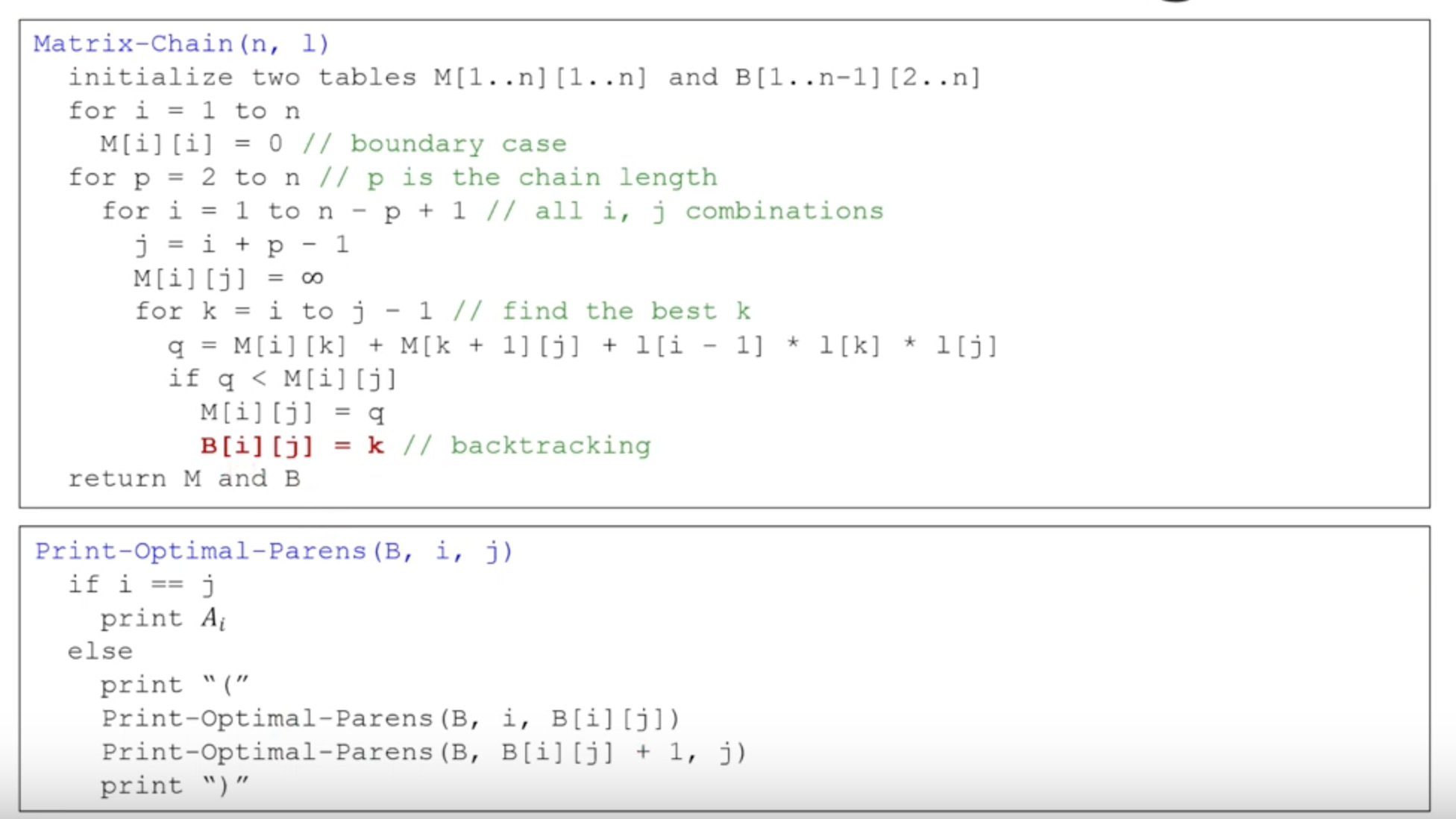Matrix Chain Multiplication
Input: a sequence of n matries $(A_1, …, A_n)$
Output: the product of $A_1A_2 … A_n$


根據 Associative (結合律) 可以將問題重新定義為: Matrix Chain Multiplication Problem
相關說明可參考: Observation
Observation

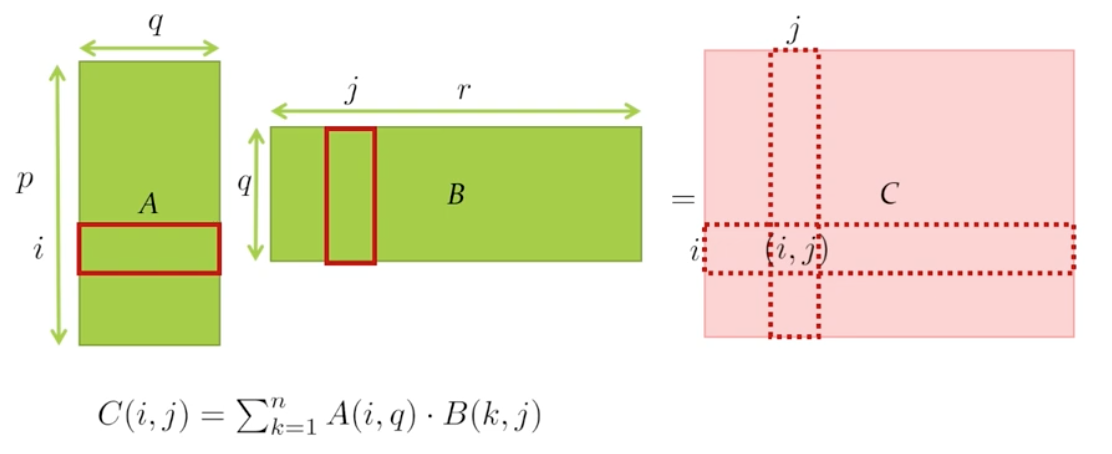
- Each entry takes $q$ multiplications
- There are total $pr$ entries
Time-Complexity: $\Theta(q)\Theta(pr) = \Theta(pqr)$
Associative (結合律)
矩陣相乘是有結合律的,如: A(BC) = (AB)C
在一個包含有二個以上的可結合運算子的表示式,只要運算數的位置沒有改變,其運算的順序就不會對運算出來的值有影響
思考: 能不能找到有效率的乘的方式,減少花的時間
Example:
矩陣相乘為: (nx1) (1xn) (nxn)
如果按照左至右順序相乘,如下圖:

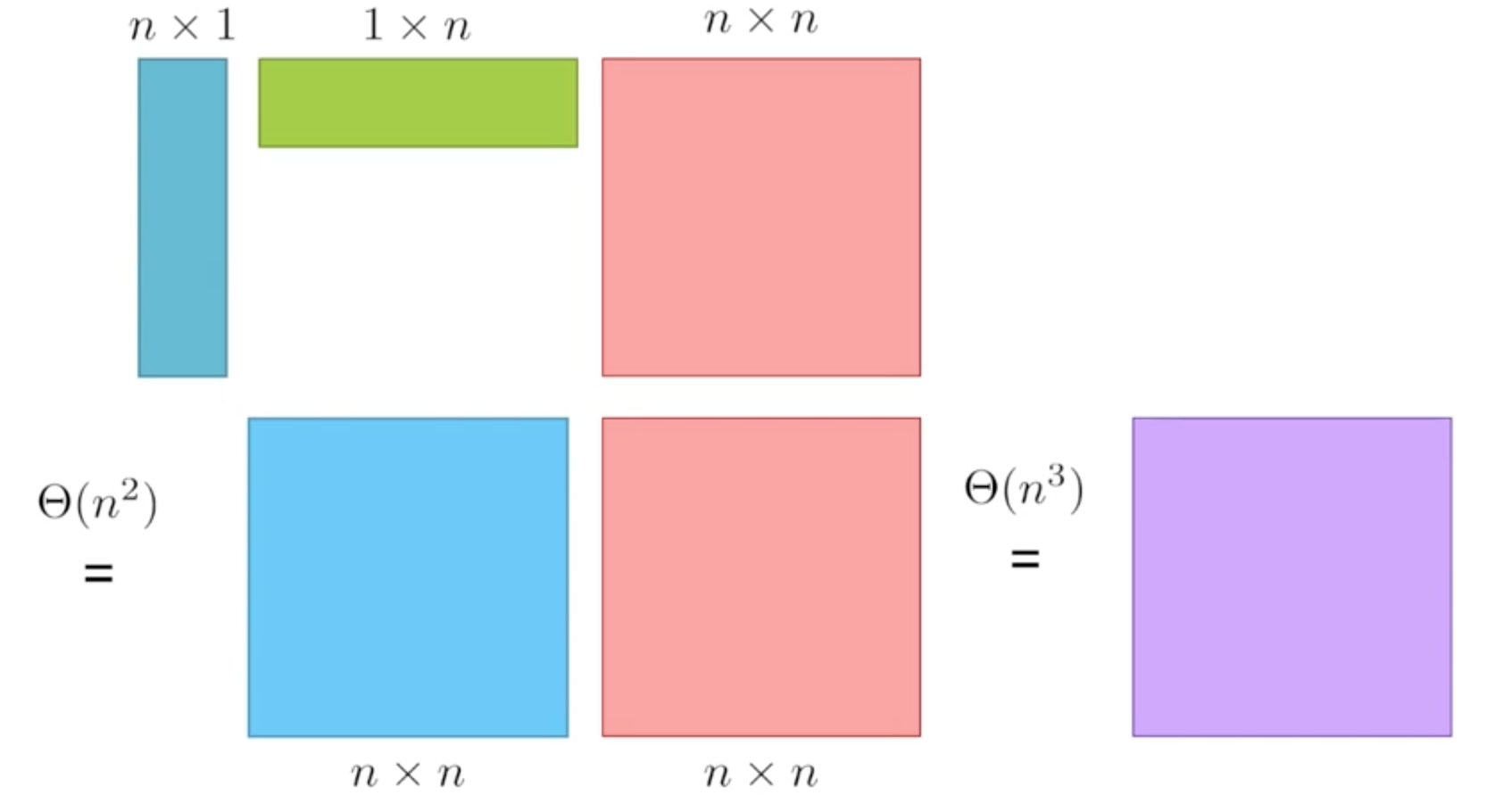
- Overall time is $\theta(n^2) + \theta(n^3) = \theta(n^3)$
但如果我們先將右邊相乘再乘左邊,如下圖:

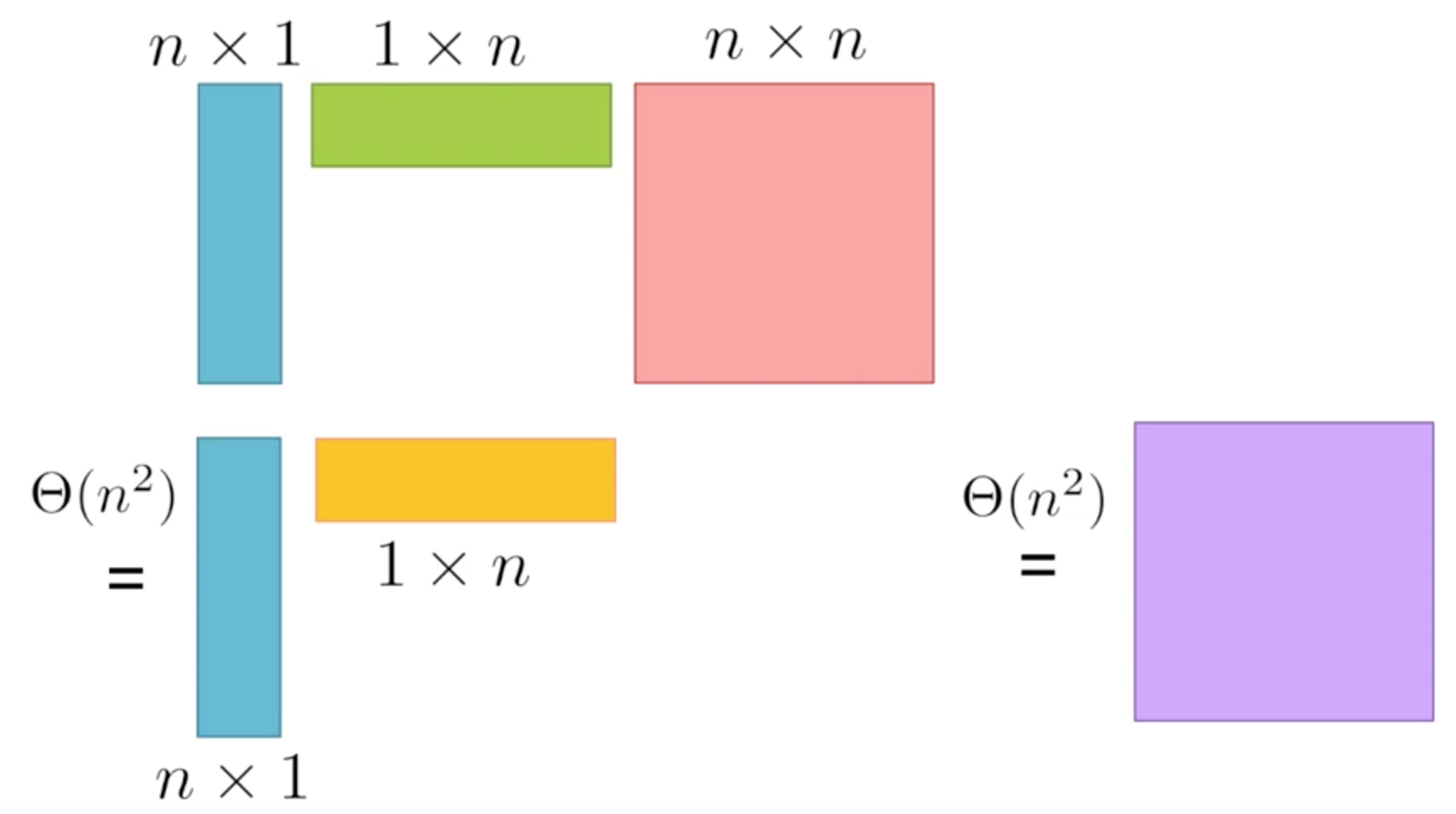
- Overall time is $\theta(n^2) + \theta(n^2) = \theta(n^2)$
> 可以找到一個好的相乘順序,來有效的降低我們的時間複雜度。
Matrix Chain Multiplication Problem
所以我們可以將問題改寫成:
Input: a sequence of integers $l_0,l_1,…,l_n$
$l_{i-1}$ is the number of rows of matrix $A_i$
$l_i$ is the number of columns of matrix $A_i$
Example:
A1 A2 A3 A4 A5 A6 30x35 35x15 15x5 5x10 10x20 20x25 A sequence of integers is: [30, 35, 15, 5, 10, 20, 25]
For A1: $l_0$ (30) is row, $l_1$ (35) is column
Output: an
orderof performingn-1matrix multiplication in the minimum number of operations to obtain the product of $A_1A_2…A_n$


Brute-Force Algorithm


Dynamic Programming
Step 1. Characterize an OPT Solution
Subproblems
M(i, j): the min #operations for obtain the product ofAi ... AjGoal:
M(1, n)長度為 n 的矩陣鏈乘積,表格: M[1~n, 1~n] - M[i,j]: Mi..Mj 所需的最小相乘數 - 目標: M[1,n] (M1M2...Mn的相乘數)
Optimal substructure: suppose we know the OPT to
M(i, j), there k cases:

Case k: there is cut right after $A_k$ in OPT
左右花的運算量是 M(i, k), M(k+1, j) 的最佳解
輔助表格 B[1~n, 1~n]: 記錄分割位置 k - B[i,j]紀錄哪一個分割位置 k 造就了 M[i,j]的最小純量相乘數
Step 2: Recursively Define the Value of an OPT Solution
Suppose we know the OPT to
M(i, j), there k cases:Case k: there is cut right after $A_k$ in OPT
$$M_{i,j} = M_{i,k} + M_{k+1,j} + l_{i-1}l_jl_k$$
where:
$M_{i,k}$: 左半邊的 optimal solution 所花的相乘時間
$M_{k+1,j}$: 右半邊的 optimal solution 所花的相乘時間
$l_{i-1}l_jl_k$: 左右半邊乘起來所花的時間。$A_{i…k}A_{k+1…j}$


Recursively define the value:


Step3: Compute Value of an OPT Solution
Bottom-Up method
How many subproblems to solve:
$combination of the values i and j s.t. $1\leq i\leq j\leq n$
$$T(n) = C_{2}^n + n = \Theta(n^2)$$
- $C_{2}^n$: $i\neq j$
- $n$: $i = j$


- $T(n) = \Theta(n^3)$
Implement with Python
Input:
| A1 | A2 | A3 | A4 | A5 | A6 |
|---|---|---|---|---|---|
| 30x35 | 35x15 | 15x5 | 5x10 | 10x20 | 20x25 |
A sequence of integers l is: [30, 35, 15, 5, 10, 20, 25]
所以維度 list 的長度 = 所須相乘矩陣數量 + 1
Recursive case:
$$M_{i,j} = M_{i,k} + M_{k+1,j} + l_{i-1}l_jl_k$$
Table M:
*** p 就是從對角線開始往右上遍歷 (每一個橫排),如下:
n = 5
for p = 2 to n
for i = 1 to n - p + 1
j = i + p - 1
1 2 3 4 5
1 x # $ % @ | p = 5 (@)
2 0 x # $ % | p = 4 (%)
3 0 0 x # $ | p = 3 ($)
4 0 0 0 x # | p = 2 (#)
5 0 0 0 0 x | p = 1 (x)
- 表格詳細說明請看: 如何建立及填表格
Python Code:
def matrix_chain_product(l, n):
"""
Matrix Chain Multiplication:
given a list of integers corresponding to the dimensions
of each pair of matrices forming a chain.
Args:
l: A list of integers corresponding to the dimensions.
n: The length of l
Returns:
M: is the minimum number of scalar multiplications needed
to compute the product of matrices A(i), A(i+1), ..., A(j)
B: is the index of the matrix after which the product
is split in an optimal parenthesization of the matrix product.
"""
# Initialize: Build the table
M = [[0] * n for _ in range(n)]
B = [[0] * n for _ in range(n)]
# Base case: 1~n 對角線上皆為 0
for i in range(1, n):
M[i][i] = 0
# compute table
for p in range(2, n): # p is the chain length (subsequence lengths)
for i in range(1, n - p + 1): # all i, j combinations
j = i + p - 1
M[i][j] = sys.maxsize
for k in range(i, j): # find the best k
q = M[i][k] + M[k + 1][j] + l[i-1]*l[k]*l[j]
if q < M[i][j]:
M[i][j] = q
B[i][j] = k
return (M,B)
[補充說明]: 如何建立及填表格

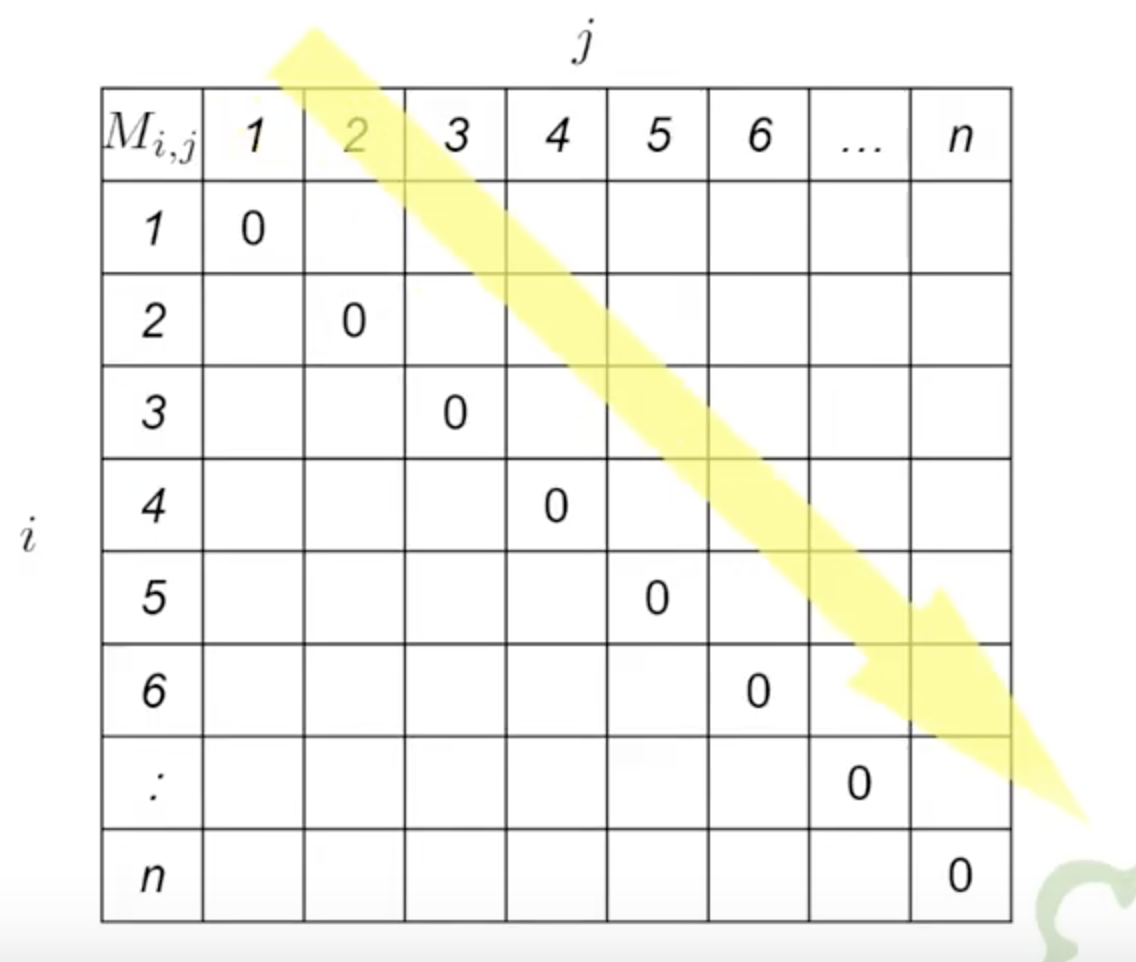

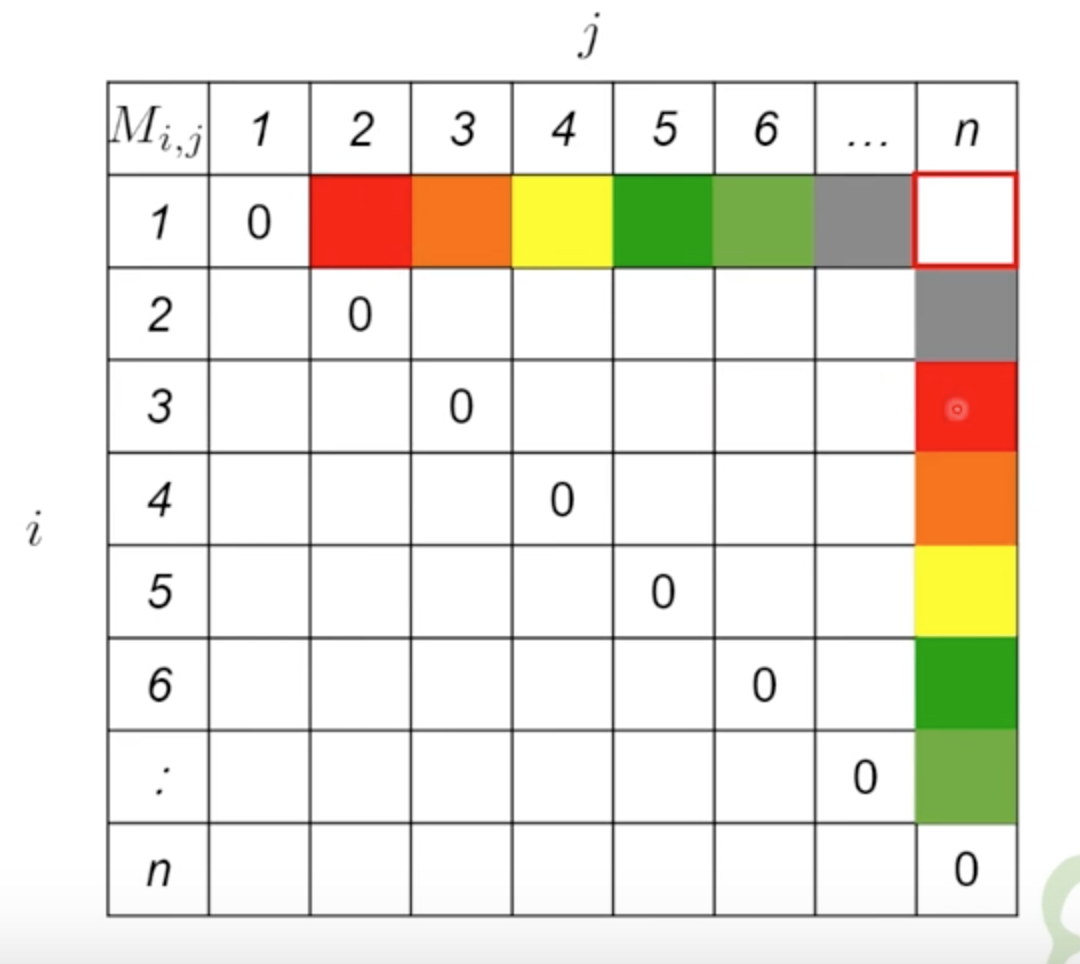
以紅色舉例說明:
M(1, 2), M(3, n)
-> 代表切在 A2,所以 A1A2 要先處理,A3..An要先處理
-> 然後再將兩個相乘
Example:




首先第一條斜線就是左右相乘,如:
A1 x A2 = (30x35) x (35x15)
=> T(pqr) = 30 x 35 x 15 = 15750
依此類推,如下圖所示:

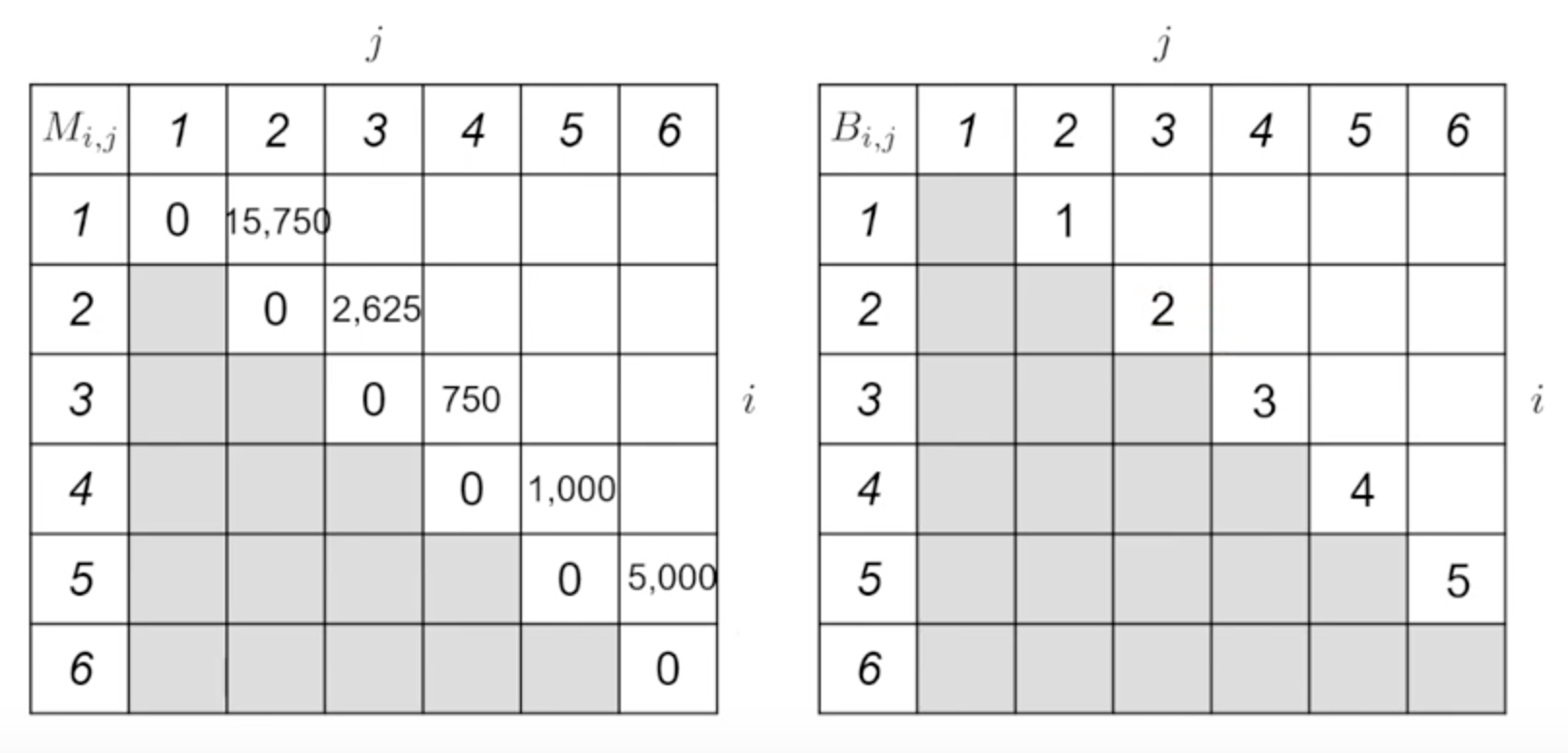
第二條斜線則是要根據左邊與下面的表格來判斷,如:
$M_{1,3}$ 有兩種方式:
- $M_{1,2}$ + $M_{1,2} * A_3$ 的時間 (從左邊)
M(1,2) x A3 = (30x15) x (15x5)
=> T(pqr) = 30 x 15 x 5 = 2250
M(1,2) + M(1,2) x A3 = 15750 + 2250
= 18000
- A1 * $M_{2,3} + $M_{2,3}$ 的時間 (從下面)
A1 x M(2,3) = (30x35) x (35X5)
=> T(pqr) = 30 x 35 x 5 = 5250
A1 x M(2,3) + M(2,3) = 5250 +2625
= 7875
可得 $M_{1,3}$:
切點為 1 (A1): B(1,3) = 1計算花費時間為
7875: M(1, 3) = 7875先乘 A2, A3 最後再乘 A1 (切點為A1)
如下所示:

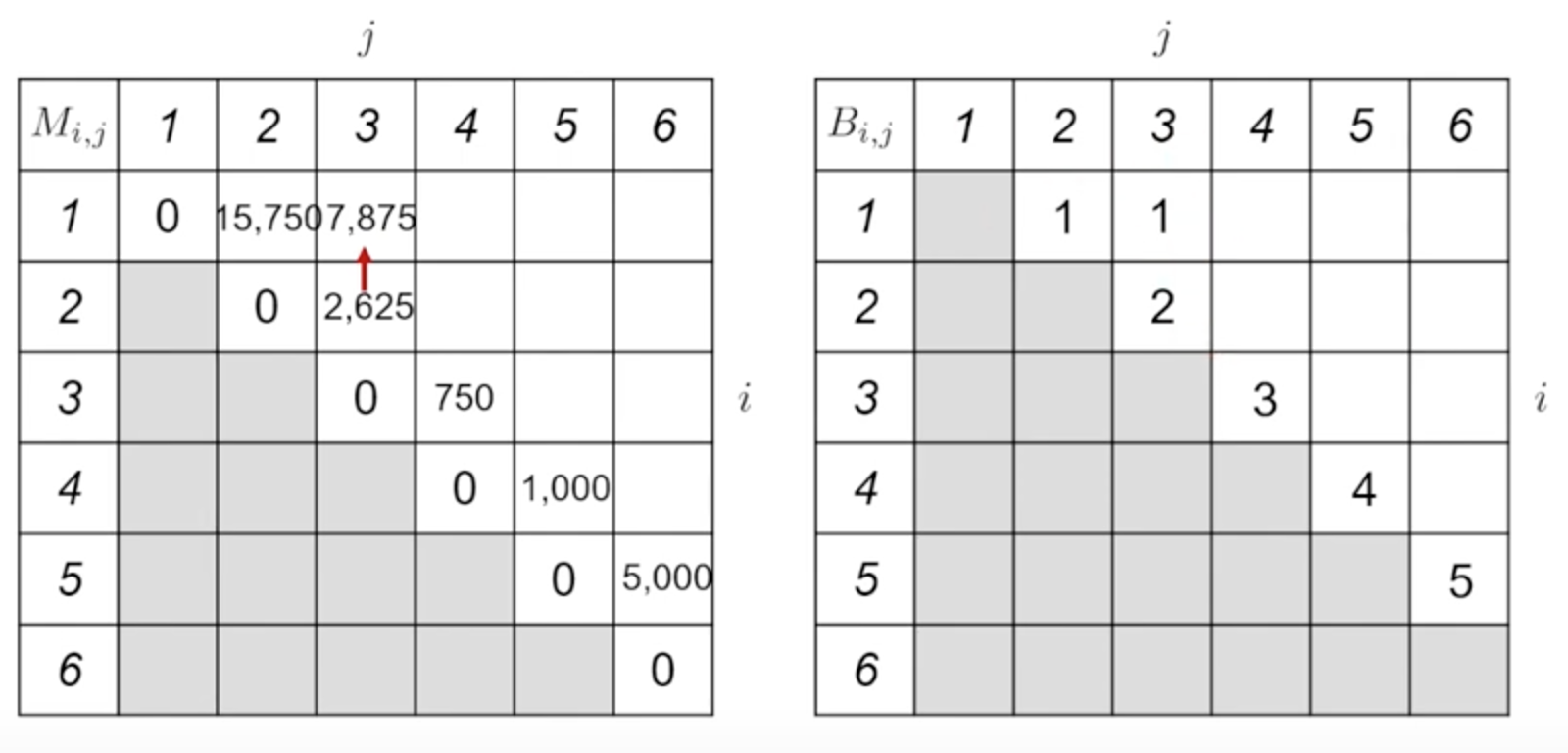
依此方法依序完成表格,如下所示:

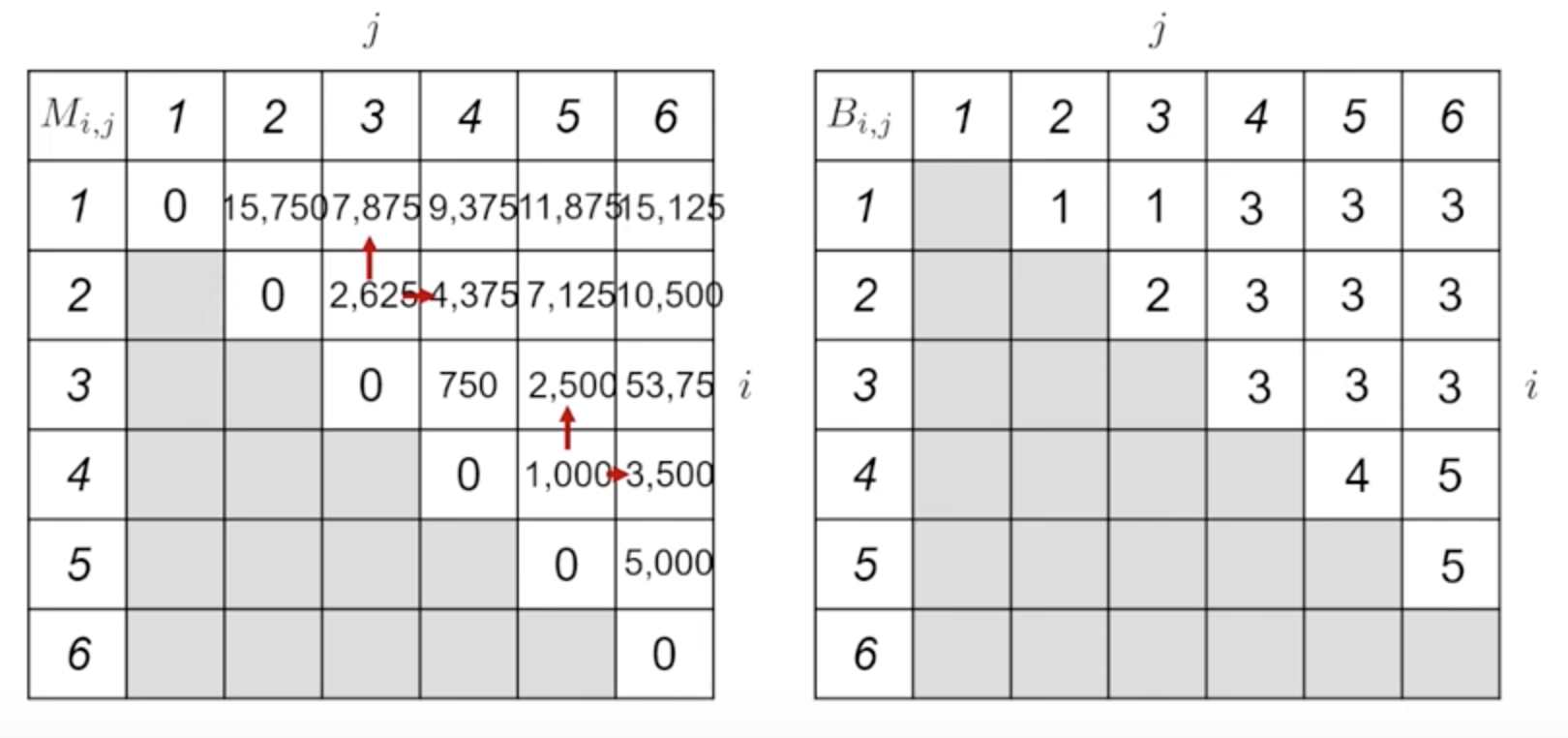
所以最後根據表格可得:
M(1,6) = M(1,3) x M(4,6)
= (A1(A2A3)) x ((A4A5)A6)
如下圖所示:

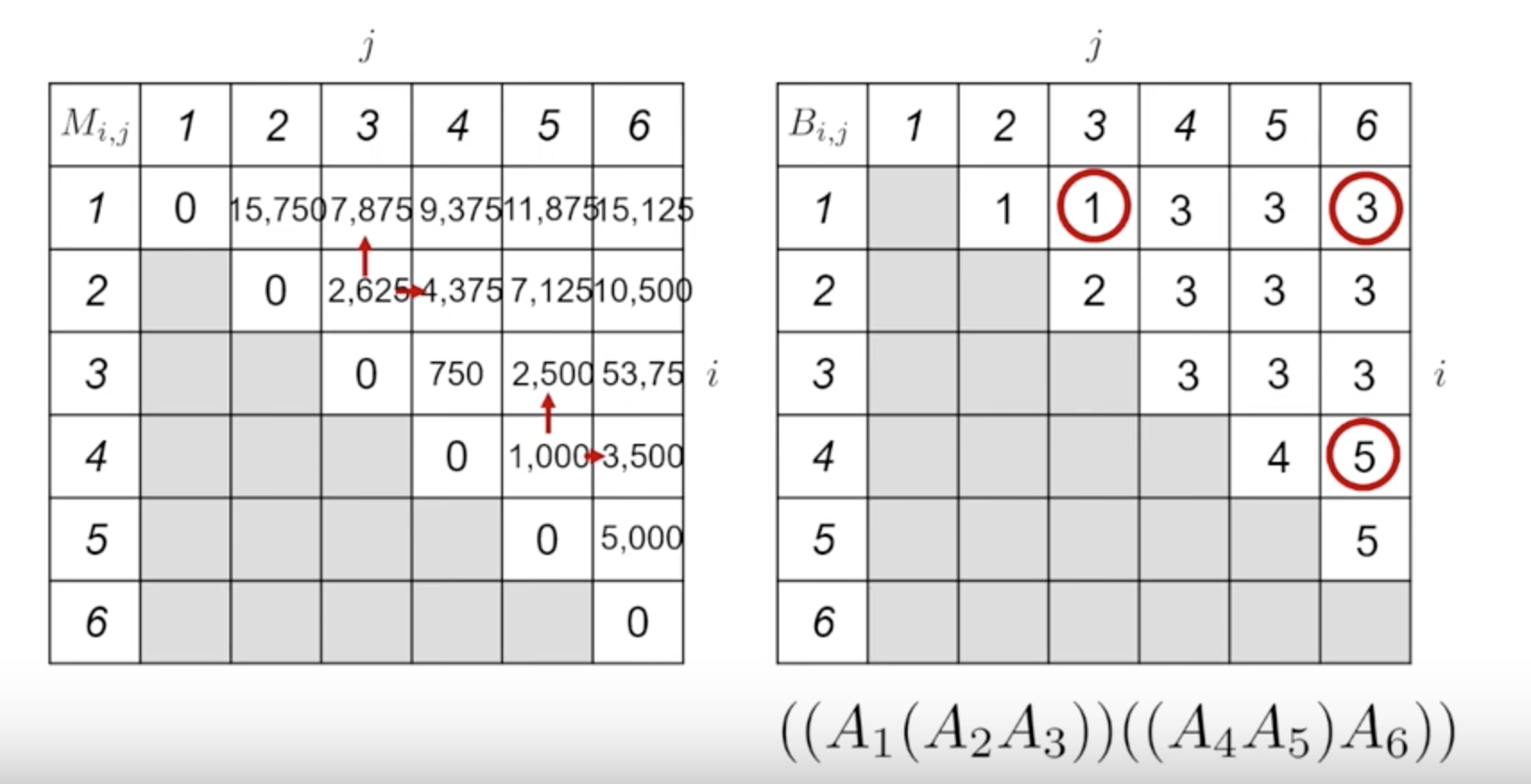
Step4: Construct an OPT Solution by Backtracking

